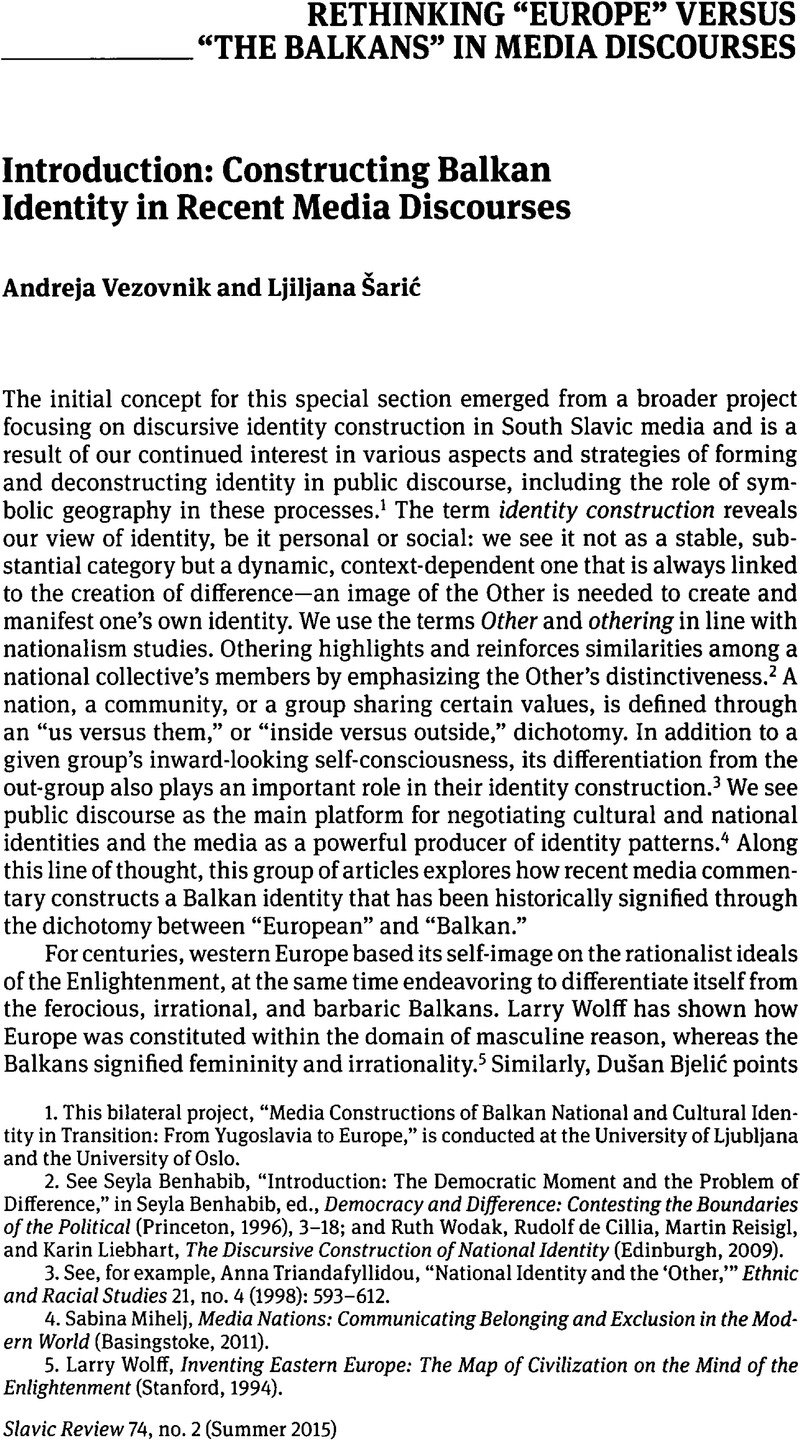Article contents
Introduction: Constructing Balkan Identity in Recent Media Discourses
Published online by Cambridge University Press: 20 January 2017
Abstract

- Type
- Rethinking “Europe” Versus “The Balkans” in Media Discourses
- Information
- Copyright
- Copyright © Association for Slavic, East European, and Eurasian Studies. 2015
References
1. This bilateral project, “Media Constructions of Balkan National and Cultural Identity in Transition: From Yugoslavia to Europe,” is conducted at the University of Ljubljana and the University of Oslo.
2. See Benhabib, Seyla, “Introduction: The Democratic Moment and the Problem of Difference,” in Benhabib, Seyla, ed., Democracy and Difference: Contesting the Boundaries of the Political (Princeton, 1996), 3–18 CrossRefGoogle Scholar; and Wodak, Ruth, de Cillia, Rudolf, Reisigl, Martin, and Liebhart, Karin, The Discursive Construction of National Identity (Edinburgh, 2009)Google Scholar.
3. See, for example, Triandafyllidou, Anna, “National Identity and the ‘Other,’” Ethnic and Racial Studies 21, no. 4 (1998): 593–612 CrossRefGoogle Scholar.
4. Mihelj, Sabina, Media Nations: Communicating Belonging and Exclusion in the Modern World (Basingstoke, 2011)CrossRefGoogle Scholar.
5. Wolff, Larry, Inventing Eastern Europe: The Map of Civilization on the Mind of the Enlightenment (Stanford, 1994)Google Scholar.
6. Bjelić, Dušan I., “Introduction: Blowing Up the ‘Bridge,’” in Bjelić, Dušan I. and Savić, Obrad, eds., Balkan as Metaphor: Between Globalization and Fragmentation (Cambridge, Mass., 2002), 1–22 CrossRefGoogle Scholar.
7. Edward Said, Orientalism (New York, 1979).
8. See Bjelić, “Introduction.”
9. See ibid.; Todorova, Maria, Imagining the Balkans (Oxford, 1997)Google Scholar; Bakić-Hayden, Milica, “Nesting Orientalisms: The Case of Former Yugoslavia,” Slavic Review 54, no. 4 (Winter 1995): 917-31CrossRefGoogle Scholar; and K. E. Fleming, “Orientalism, the Balkans, and Balkan Historiography,” American Historical Review 105, no. 4 (October 2000): 1218-33.
10. Fleming, “Orientalism”; Bakić-Hayden, Milica and Hayden, Robert M., “Orientalist Variations on the Theme ‘Balkans’: Symbolic Geography in Recent Yugoslav Cultural Politics,” Slavic Review 51, no. 1 (Spring 1992): 1–15 CrossRefGoogle Scholar.
11. Woodward, Susan L., Socialist Unemployment: The Political Economy of Yugoslavia, 1945-1990 (Princeton, 1995)CrossRefGoogle Scholar.
12. Patrick Hyder Patterson, , “On the Edge of Reason: The Boundaries of Balkanism in Slovenian, Austrian, and Italian Discourse,” Slavic Review 62, no. 1 (Spring 2003): 110-41CrossRefGoogle Scholar.
13. Ibid. See also Hammond, Andrew, British Literature and the Balkans: Themes and Contexts (Amsterdam, 2010)CrossRefGoogle Scholar; Hammond, Andrew, The Debated Lands: British and American Representations of the Balkans (Cardiff, 2007)Google Scholar; Bakić-Hayden and Hayden, “Orientalist Variations”; Bakić-Hayden, “Nesting Orientalisms“; Ingrid Hudabiunigg, “Slowenien in der deutschen Presse,” in Karmen Teržan Kopesky and Teodor Petrić, eds., Germanistik im Kontaktraum Europa 2, vol. 1, Literatur (Maribor, 2003), 346-61; and Hudabiunigg, Ingrid, “The Otherness of Eastern Europe,” Journal of Multilingual and Multicultural Development 25, nos. 5-6 (Winter 2004): 369-88CrossRefGoogle Scholar.
14. See, for example, Marion Kraske, “Deutsche vom Balkan,” Der Spiegel, December 31, 2007, at spiegel.de/spiegel/print/d-55231875.html (last accessed February 10, 2015).
15. Bakić-Hayden and Hayden, “Orientalist Variations.”
16. See Bjelić, “Blowing Up.”
17. See Tanja Petrović, “Dolga pot domov: Reprezentacije zahodnega Balkana v političnem in medijskem diskurzu” (PhD diss., Mirovni inštitut, 2009); and Dubravka Kuna, “Diskursna analiza imenovanja i opisa naroda i država u hrvatskom dnevnom tisku” (PhD diss., University of Osijek, in progress).
18. See Kordić, Snježana, Jezik i nacionalizam (Zagreb, 2010)Google Scholar; Mario Grčević, “Some Remarks on Recent Lexical Changes in the Croatian Language,” in Radovan Lučić, ed., Lexical Norm and National Language: Lexicography and Language Policy in South-Slavic Languages after 1989 (Munich, 2002), 150-63, at http://wwwO.ids-mannheim.de/prag/sprachvariation/fgvaria/croatian_lexical_changes.pdf (last accessed February 10, 2015); and Langston, Keith and Peti-Stantić, Anita, Language Planning and National Identity in Croatia (Basingstoke, 2014)CrossRefGoogle Scholar.
19. See Billig, Michael, Banal Nationalism (London, 1995)Google Scholar.
20. Dolar, Mladen, “Slovenska nacionalna identiteta in kultura: Navodila za uporabo,” in Pagon, Neda, ed., Nacionalna identiteta in kultura (Ljubljana, 2003), 21–36 Google Scholar.
21. See Velikonja, Mitja, Evroza: Kritika novega evrocentrizma / Eurosis: A Critique of the New Eurocentrism (Ljubljana, 2005)Google Scholar.
22. See Nataša Zambelli, “East of Eden: A Poststructuralist Analysis of Croatia's Identity in the Context of EU Accession” (PhD diss., University of Edinburgh, 2011).
23. Said, Orientalism, 332.
- 2
- Cited by


